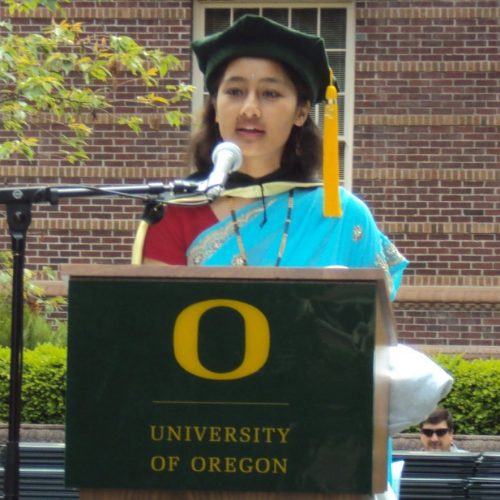Voices from the Sylff Community
Aug 15, 2025
Toward More Meaningful Inclusion of Indigenous Traditions in Nepal’s Climate Resilience Efforts
An SLI forum organized by Shangrila Joshi (University of Oregon, 2008) in May 2025 explored how Nepal’s Machchhindra Nath Jatra exemplifies Indigenous climate resilience and how traditional governance can inform inclusive, sustainable policy in the face of growing environmental challenges.
* * *
That Indigenous Peoples’ rights, knowledge, and concerns should be an important consideration in climate policy and action is today undisputed. Both the current global climate treaty, the Paris Agreement, and the most recent report by the Intergovernmental Panel on Climate Change (IPCC) emphasize this sentiment in no uncertain terms.
However, it is one thing to assert that something or someone is important. It is an entirely different matter to translate such assertions into meaningful action. To explore how such inclusion might be realized, I organized an SLI forum aimed at identifying meaningful ways to integrate Indigenous Peoples into climate action and policy.
Following a two-year ethnographic study, I am currently writing a book on the Machchhindra Nath Jatra held annually in Nepal. This is an ancient festival tradition practiced by the Newa people indigenous to the Kathmandu Valley that is believed to have been initiated in the seventh century CE in response to a 12-year drought. The jatra reflects a deep interconnection between Indigenous ways of knowing, being, and governing.
The festival is centered on the deity Machchhindra Nath—also known as Karunamaya, Avalokiteswor, and Bungdya—who is regarded as being responsible for bringing monsoon rains to the valley following the drought and is entrusted with protecting the valley’s residents from catastrophes. The contemporary Newa communities responsible for planning and executing the jatra continue to maintain a deep faith in the deity and the surrounding mythology.
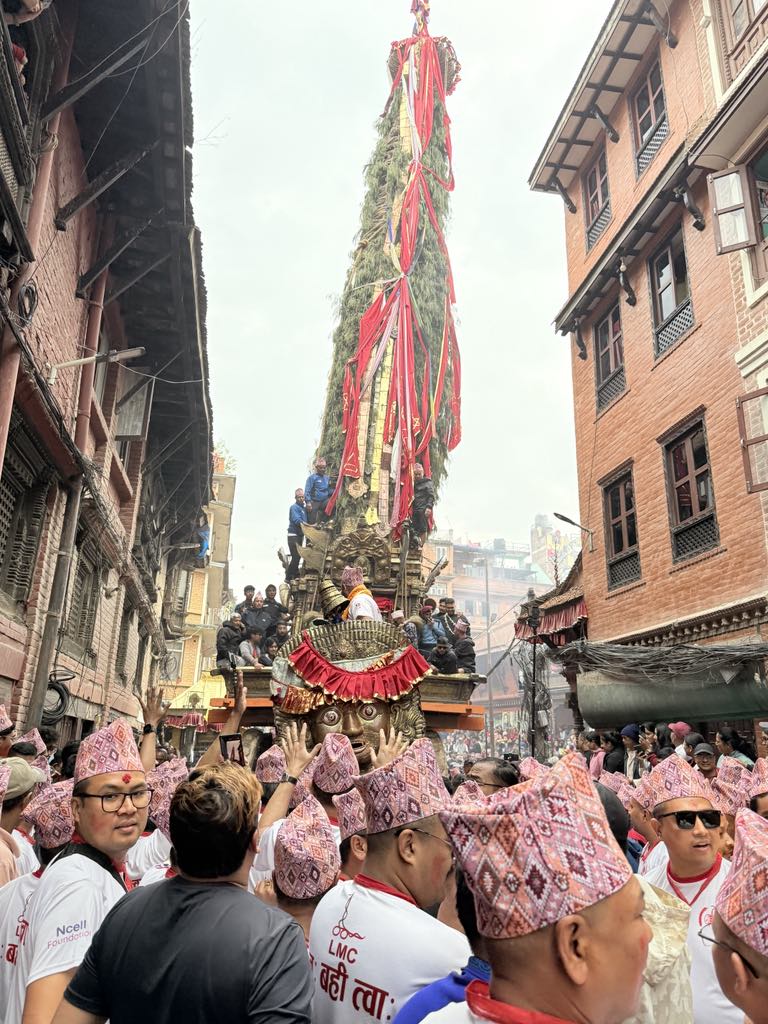
The Machchhindra Nath chariot during the 2082 BS (2025 CE) procession through the streets of Patan.
More than a dozen social groups with expertise in different functions have niche roles to play in sustaining this important festival. I argue that an Indigenous Newa governance institution called the guthi is integral to the continuity of the work of these groups and therefore of this culturally and ecologically significant tradition. Guthi associations mobilize members of particular caste and clan groups to fulfill their ancestral duties. Historically, guthis were self-governing groups that invested surplus resources from agriculture to build the art and architecture of the Kathmandu Valley.
Not to be mistaken with the Newa guthi, the Guthi Sansthan is the state apparatus that controls appropriated traditional guthi lands and their financial surplus. It mobilizes some of these funds to sponsor the jatra and to minimally compensate hereditary guthi members for their labor.
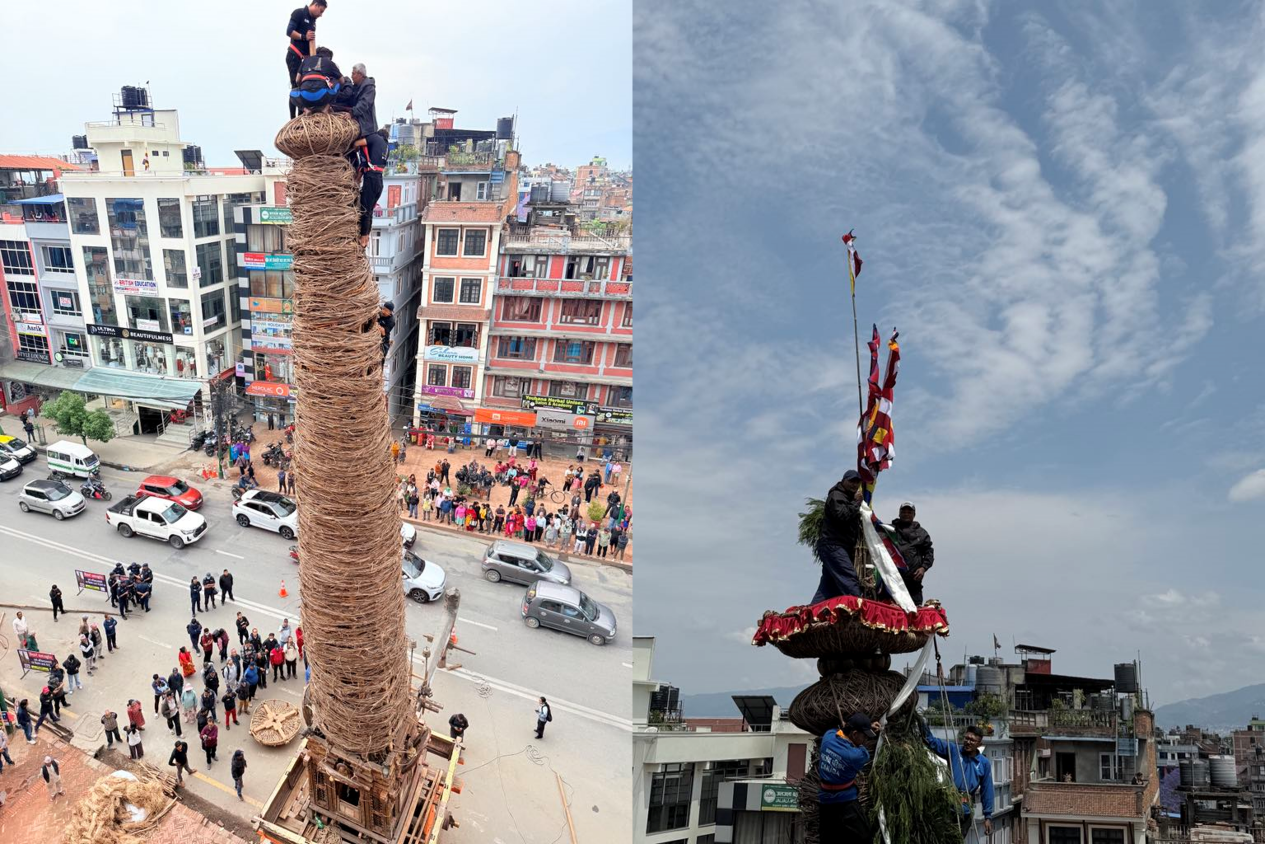
Yanwa builders placing the ceremonial gwaro bamwo rattan disc, left, atop the Machchhindra Nath chariot, made from rattan and wood by Yanwa and Barahi builders, April 28, 2025. Yanwa builders putting the finishing touches on the decorated chariot, right, just before embarking on the annual procession, or Rath Jatra, May 1, 2025. Both photos by Shangrila Joshi.
Bringing Together Diverse Voices for Climate Adaptation
My SLI forum project, titled “The Significance of the Machchhindranath Jatra and the Newa Guthi for Climate Adaptation in Nepal,” drew the attention of Nepalese decision-makers on climate policy and action in government and nongovernment spaces to the relevance of this tradition as well as to the Indigenous Newa governance institution for contemporary climate adaptation and resilience. It created an opportunity for disparate groups working within their own spheres of influence to exchange knowledge, perspectives, and experience and to understand the relevance of one another’s contributions to Nepalese society and to global climate discourse.
During the planning phase of the SLI project, I met on numerous occasions with Indigenous community leaders and both government and nongovernment representatives. These preparatory sessions culminated in two half-day workshops and a full-day forum in May 2025, attended by over 150 participants, including Indigenous community leaders, experts from environmental agencies and cultural institutions, and government representatives.
The workshops featured discussions on the historical context and contemporary relevance of the festival tradition and the guthis for climate resilience and highlighted the important contributions made by the Yanwa, Barahi, Ghakku, Paneju, and other groups in sustaining this intangible heritage: the Yanwa and Barahi build the chariot from wood and rattan, the Ghakku guide the movement of the chariot’s wheels during the procession, and the Paneju perform worship and tantric rituals.
Also noteworthy were discussions about the unique challenges faced by members of the separate festival communities. Several participants emphasized the meeting’s historic significance for bringing together disparate groups in one venue and for recognizing both their contributions to society and the difficulties they face in sustaining their traditions and roles.
The day-long forum drew 61 participants, including key members of the various festival committees, expert representatives from the Ministry of Forests and Environment and the Ministry of Agriculture and Livestock Development, and representatives of nongovernmental organizations focused on Indigenous issues, such as the Center for Indigenous Peoples’ Research and Development (CIPRED) and the Nepal Federation of Indigenous Nationalities (NEFIN). Special guests included a former Kumari (living goddess of Patan) and cultural expert Hari Ram Joshi.
The program enabled the sharing of expertise among a diverse group of participants and fostered interactive discussions on key themes of environmental and cultural sustainability, Indigenous knowledge, and the integration of both in the context of climate policy and action.
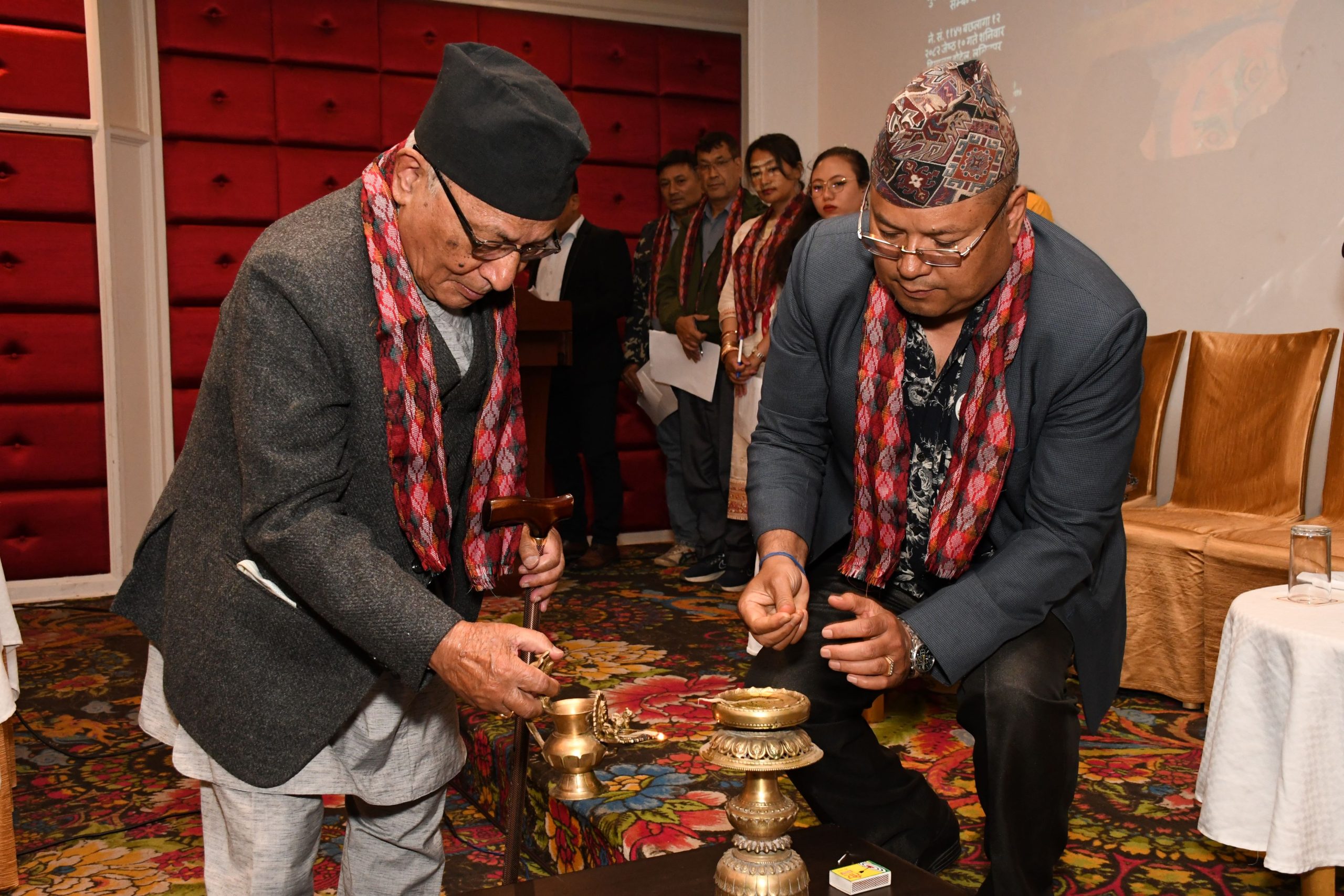
Feted scholar of Nepalese culture and history Hari Ram Joshi, left, inaugurating the multi-stakeholder forum on May 24, 2025, with past Kumari Chanira Bajracharya, Sylff fellow Shangrila Joshi, chair of the Paneju Sangh Yagya Ratna Shakya, and Dependra Shakya looking on.
Toward Integrated Climate and Cultural Policy
The forum concluded with government and civil society representatives reiterating the importance of viewing Indigenous traditions such as the jatra through the Indigenous point of view and acknowledging the need to significantly strengthen the implementation of international agreements such as the Indigenous and Tribal Peoples Convention (ILO 169) and the United Nations Declaration on the Rights of Indigenous Peoples (UNDRIP), both of which Nepal has endorsed.
Meanwhile, Indigenous community leaders reaffirmed their commitment to continue their ancestral traditions even as, according to their accounts, doing so has become increasingly challenging, given dwindling resources available to dedicate to this festival in light of the encroachment on guthi lands.
The interactive discussion among forum participants led to substantive recommendations, including the need to invest in research and documentation of this culturally and ecologically significant tradition, as well as to initiate proposals for land reforms that would enable the Indigenous groups responsible for sustaining the tradition to sufficiently draw on traditional guthi lands to sponsor their duties pertaining to the tradition. The different guthi associations connected to the tradition revealed unique circumstances and challenges toward sustaining their community functions but were in agreement that Indigenous representation within the leadership ranks of the Guthi Sansthan was integral to long-term sustainability.
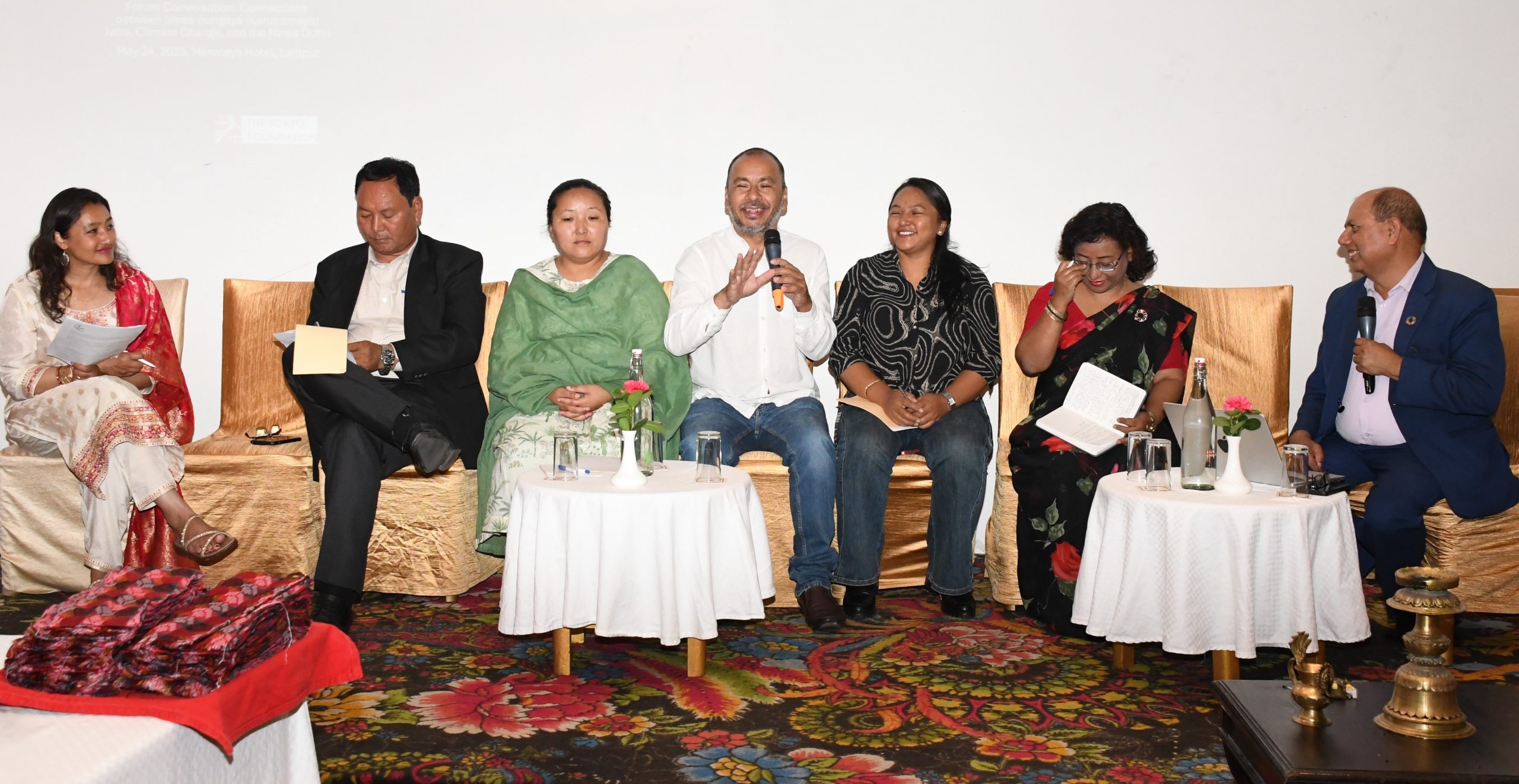
A panel discussion on the role and inclusion of Newa traditional ecological knowledge in climate adaptation and resilience, with panelists, left to right, Shangrila Joshi, Pasang Sherpa (CIPRED), Lakpa Dhokpya (NEFIN), cultural preservation activist Alok Tuladhar, intangible heritage expert Monalisa Maharjan, session chair Matina Joshi (joint secretary and spokesperson at the Ministry of Agriculture and Livestock Development), and session moderator Sindhu Dhungana (climate expert and past-joint secretary, Ministry of Forests and Environment).
These recommendations underscore the urgent need to bridge traditional knowledge systems with modern climate policy, ensuring that Indigenous voices are not only heard but actively shape Nepal’s climate future.
